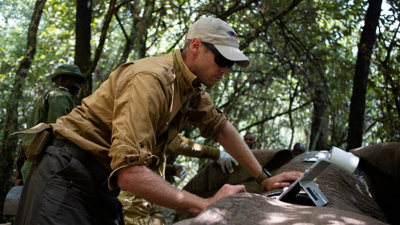Nominations for the 2026 Esmond B. Martin RGS Prize are closing next month on 15 December. The Prize awards a candidate who has made a big impact in the field of geographical research, with a particular emphasis on wildlife conservation and environmental research studies.
Ahead of the nominations closing, we’re spotlighting the work of one of the 2025 winners, Dr Jake Wall, who, alongside Dr Iain Douglas-Hamilton, was awarded the Prize for his extraordinary efforts to equip conservationists with the tools and methods to protect the natural world.
Conservation technology - turning data into action
For the last 20 years, Dr Jake Wall has harnessed technology to create freely available geospatial tools for the benefit of wildlife conservation, in particular, of elephants. His work demonstrates the growing role of data in driving more effective conservation efforts in Africa and beyond. Jake’s path to this area of work was sparked by a chance encounter with renowned conservationist and founder of Save the Elephants, Dr Iain Douglas-Hamilton. Jake’s passion grew upon seeing the possibilities of science and research when applied to conservation of elephants.
As individualistic and highly adaptable generalists, elephants aren’t always seen as the most immediate victims of climate change and human encroachment. However, expanding agriculture, increased fencing, poaching and deforestation have created unique problems for elephants and the landscapes they depend on. From breaking electric fencing to raiding crops, their intelligence and problem-solving skills often bring them into conflict with people, making coexistence a key priority for conservationists. Mapping and visualising data from tracking collars over the last 25 years has revealed the subtleties of elephant movement ecology and identified where targeted intervention can have greatest impact:
Tracking data provides us with an incredible and intricate view into where an elephant went, and when, from which we can figure out the environmental conditions the elephant experienced, the types of vegetation it encountered, and possibly who it met along the way. The challenge is to know why the elephant chose the path it did and how can we use that information to protect populations.Jake
Research by Iain and Professor Fritz Vollrath in 2004 into ‘streaking’ - the sudden movement of elephant across long distances - revealed sections where elephants often retrace the same routes in such large numbers that their path forms vital wildlife corridors across the landscape. Visualising these movement patterns brings to life an overlooked issue whereby those corridors are under growing threat. The rapid expansion of fencing in recent years, increasing by 170% in the Greater Mara alone since 2010, has disastrous impacts on movement-based ecological processes. Sharing and analysing movement data enables conservationists to identify and protect these critical corridors and maintain habitat connectivity. Such insights have already driven practical solutions, from building wildlife underpasses allowing safe road crossings to generating support for collaborative initiatives specifically focused on corridors.
The accessibility of these datasets and the tools to easily interpret them is essential in a field where funding and resources are limited. Through strategic partnerships, Jake’s ideas and technical solutions have been scaled up, placing greater power and potential in the hands of conservationists worldwide:
- In 2014, Microsoft co-founder, Paul Allen, funded EarthRanger, an open-source platform for ecosystem monitoring, research and management. It brings together data from hundreds of different types of sensors including tracking collars, satellite imagery and weather stations to present data feeds and create tailored alerts such as when an elephant crosses a virtual boundary. Today, it delivers cutting-edge monitoring to more than 10,000 users globally, and tracks over 23,000 animals via GPS.
- Jake is now leading the development of Ecoscope, the latest project that builds on movement ecology tools. The recently launched platform provides access to ready-made analytics from sources of conservation and remote-sensing data streams, allowing researchers and conservationists to easily engage with data and generate meaningful outputs to improve decision making, insight and the protection of ecosystems.
Jake and his colleagues know how urgent it is that we build a future for people and wildlife to coexist, and geographers and GIS specialists are crucial to laying those foundations.
To succeed, we require a new generation of quantitative conservationists…who are not only able to collect and use data to understand and protect ecosystems but who are, at the core, in love with nature.Jake
Submit nominations for the 2026 Prize
Do you know anyone suitable for the Prize? Any individual may nominate a candidate for the Esmond Bradley Martin Prize.
If you have any queries about the 2026 Prize and making a nomination, please contact director@rgs.org.



